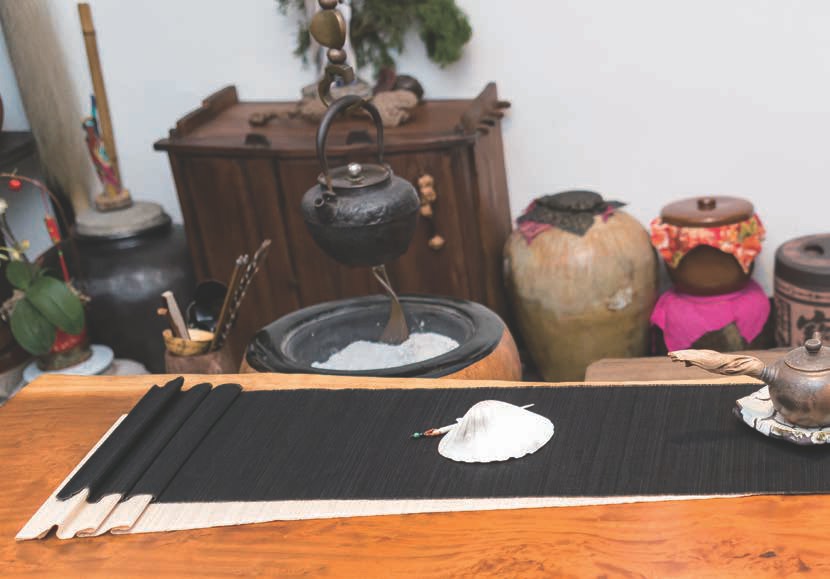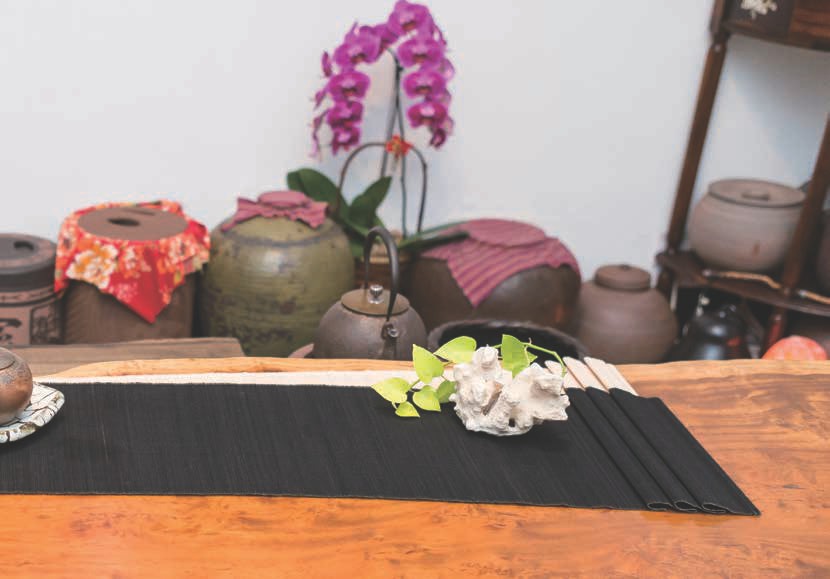
 |
|
In our last article on chaxi we reviewed the basics, dappling in more surface level, practical concepts, but not forgetting that if we are to master anything we must first master the basics! This month, I'd like to discuss the specific elements of a tea stage in a little more detail. It's been almost two years since we last covered this topic in our magazine, and for any of you who have visited our center more than once, you'll know that things change fast around here! Physical aspects of the center are improved, the way we brew tea is refined, and the center schedule adapts towards more structure, not to mention we as individuals change drastically as we learn to more skillfully wade through the vicissitudes of life. As such, our chaxi has shifted over the years to suit the needs of our growing center and with a now much larger Global Tea Hut membership; it's about time to review the elements of chaxi once again!
An article on the elements of anything wouldn't be complete without due respect to Nature, for what are the elements if not aspects of Nature Herself? Remember that when you are creating a chaxi for your tea ceremony that it is akin to building a temporary altar. A beautiful, thought-out and well-designed chaxi honors Nature as we bring the elements together in a balanced way for a brief period of time. Like an altar, the elements should be balanced and focus one's attention towards the center, where the god or goddess rests, or in our case, where the Tea is made.
When crafting your chaxi it is important to first consider the size of your tea space and the number of guests. This will help guide all other decisions. In this way, function comes first and form second. A large tea space with many guests will generally require a far different set of elements than that of a smaller tea space with less guests. It is so important that your chaxi function well for the occasion, just as a teapot should primarily function well and then delight the eye. A beautiful teapot that doesn't do its "job" ends up a display piece, and that is a shame. No matter how beautiful the teaware, it must work well first... Clearly, the ideal is a teapot or chaxi that both functions well and stirs the aesthetic spirit in all of us! Just as the ideal for food should be that it is nutritious and delicious; but nutrition must come first.

Another important initial decision will be to create a rustic or elegant chaxi. This distinction is a good generality to begin with, as most all chaxi will either be refined our simple (wabi). At this point, the theme of our tea stage starts to unfold as we envision our chaxi. Here are the main elements we'll use to create our arrangements:
The chabu or tea runner/cloth will often be one of the first elements we look to. It will play a huge roll in determining whether your chaxi will be rustic or elegant, simple or refined. Chabu can be made of cloth, bamboo, sticks woven together, rattan, straw, and a variety of other materials. They can range greatly in shape, color and pattern. One thing to consider before choosing your chabu is what type of tea you will be brewing. For if you brew a dark tea in a large company, then a white, or easily-stained cloth should be avoided (unless you want stains on it), since you will have to pour faster the more guests you have in order to keep the liquor consistent. When you choose a chabu it will quite literally lay the foundation for your tea ceremony, as upon it all other elements will find their place. (You could also choose to use a piece of wood or stone, something unique or even nothing.)
With the chabu chosen, the next element will play the role of focusing our attention on the center of the stage. This is important to remember, because if the other elements are out of harmony with the theme of a chaxi, it can actually draw our attention away from what's most important - the tea! The boat or pillow will act as a surface between the base of your teapot and the chabu. Usually we use a boat in gongfu tea as it catches water that is showered over the pot, whereas a pillow is anything to rest your teapot on, more often used in bowl tea.
It is probably important to note here that in gongfu tea, function plays more of an important role than form, which doesn't mean we rule out form and beauty from gongfu tea sessions. Likewise, bowl tea, while seemingly more designed with form in mind, still must con39/ Elements of Chaxi sider function. They obviously overlap; we might say that in both gongfu and bowl tea, we start with function and work towards form, but with bowl tea, form is often more pronounced in the end. This has to do with the aim of both brewing methods, but that is a topic for another discussion altogether.
Since this element should focus our attention on the center of the stage, it should therefore contrast the chabu, while remaining in harmony with the theme and overall feeling. Sometimes, the simplest rattan trivet is enough to find that balance. Other times, a very elegant, shallow dish is just the right touch.
A noteworthy exception here is when you don't use a chabu. One such example would be a larger, flat piece of wood, upon which you wouldn't need the addition of a pillow.
A problem I sometimes forget is to carefully choose the height of the pillow. A pillow that raises the teapot higher can prove difficult to use with a larger company for bowl tea. Flat or shallow pillows are more functional. If you find yourself seated on the ground, however, a raised pillow would prove advantageous to brewing.
"The value of a piece of teaware is reflected in the tea it makes and the state of mind it brings to the space."


Scoops and sticks are often used together. The scoop is to display the tea and the stick can then guide the loose leaf into the pot and sometimes act as a spout cleaner should some leaves clog it up. One major difference I've noticed at the center over the years as we serve more people in larger numbers is a general shift away from scoops and sticks, unless they are very suited to the theme and don't constrict movement or get in the way. That being said, these will still be important elements for most people as they are extremely practical and can fill space nicely on a large chabu. Definitely don't feel forced to use them both. Sometimes, the scoop or dish used to hold the tea is all you will need. As we add more elements to our chaxi, the choice becomes increasingly difficult. We need to take into account all the other elements to find balance. In fact, great skill and aesthetic appreciation are required to create a chaxi that values emptiness as much as form. More is definitely not always better.
As you may have guessed, there is a huge range of both scoops and sticks from bamboo and copper to ceramics and even horn.
One more element you will want to consider is the waste-water basin, or jin shui. This is the vessel into which discarded water goes. Out of respect, we clean our tea and teaware before our guests. It is therefore essential to have a jin shui.
In bowl tea, we almost never display the jin shui for the entire duration of the tea ceremony, but rather only for the cleansing in the beginning. For the rest of the ceremony, it is generally kept out of site under the table or off to the side. Unlike the other elements, where having more variety to choose from offers great versatility, only one jin shui is necessary for all practical purposes. While its role is mainly functional, don't hesitate to use a beautiful jin shui in your chaxi if you have one. Otherwise, any large, open bowl will do.
In gongfu tea, the jin shui is usually present on the tea table, as we warm the pot and cups at each infusion, so it's very important to have nearby. Because it's on display, a smaller, more refined jin shui is nice to have. This could mean a larger water basin is needed off to the side to pour off the water from the smaller one.
In this tradition, we find the art of chaxi useful in our ceremonial approach to tea. A functional and aesthetic chaxi is a great way to welcome and honor your guests to the tea space, and definitely influences everyone's experience. We are fortunate to have this luxury to use as yet another tool towards cultivating a life of Tea. In that light, we craft our chaxi and invite you to join us for tea!
